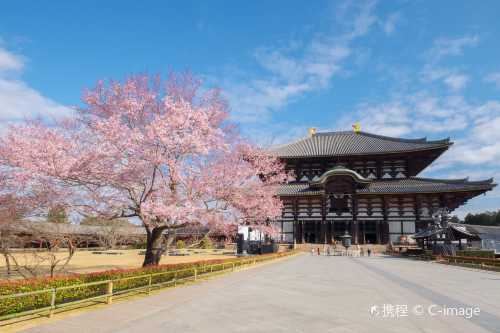Just came back from an unforgettable trip to Osaka! Exploring the colorful streets of Dotonbori, visiting the historic Osaka Castle, and catching the sunset from Umeda Sky Building were absolute highlights. Stayed at LinHouse J 101 Homestay Shin-imamiya Osaka — perfectly located above Namba Station, making travel super easy! Osaka’s street food culture is next-level — takoyaki and okonomiyaki are a must-try! Don’t miss a side trip to Kyoto and Nara especially if you’re a culture lover! Can’t wait to visit again. Osaka’s energy is so contagious! #TravelTips: Get an ICOCA or SUICA card for smooth travel around Kansai. #FoodieTip: Head to Kuromon Ichiba Market for fresh seafood and authentic street eats. #Hashtags: #Osaka #VisitJapan #Dotonbori #OsakaCastle #kyototrip #narapark #UmedaSkyBuilding #TravelJapan #ExploreOsaka #FoodieTravel #KuromonMarket #saganoromantictrain #Takoyaki #Okonomiyaki #JapanTrip #WanderlustJapan
zazamj
Popular Trip Moments
Osaka and Nara | Nara|Draw ice fortunes at the Millennium Ice Museum Shrine and enjoy the free shaved ice at the Ice Festival | Half a day of chill in Nara 🦌 | The symbol of Nara, Todaiji Temple: A journey to experience the world's largest Buddha statue and 1,300 years of history | 🇯🇵 [Nara Prefecture] Let's go see the Great Buddha at Todaiji Temple! | [French] 111th Anniversary Dinner! Main Dining Room Mikasa @ Nara Hotel | [Nara City, Kintetsu Nara] VILLA COMMUNICO: Enjoy gourmet food and relaxing time surrounded by a fire | Nara 🦌 | A thousand-year-old prayer resonates in silence | Springtime at Kasuga Taisha (Nara) | Nara’s Magic: Cherry Blossoms and Friendly Deer in Perfect Harmony | It turns out that here, you can take life photos with the deer~ | Nara's Premium Hotel | Comfort and elegance combined: A stay at JW Marriott Hotel Nara | Nara's Saho River Cherry Blossoms: So Beautiful It Makes You Want to Cry 🌸✨ | This cherry blossom season, Nara healed me. 🌸 | Sunset hike above Nara | Representative tourist attractions in the Osaka Kansai region! | Shikanokonokonokokositantan | How can you not try the Tonkatsu Ganko? | Can't help but give a thumbs up! Highly recommended~"Onyado Nonon Nara Natural Hot Spring Hotel"** | Osaka Nara|The most healing trip to Kansai in 2025☺️I will come again next time! | Locals' Secret: A Healing Journey to Unlock the Deer in Nara🦌 | Top Tips for a Perfect Nara Park Adventure | Mount Yoshino Cherry Blossoms: Japan’s Most Epic Sakura Destination | Nara in Bloom: Where History Meets Hanami | Nara~A place to get close to nature, visit cute deer and historical and cultural heritage. | Nara | A Hidden Gem for Cherry Blossoms in Kansai 🌸🚶♀️ | Nara | Stunning Cherry Blossoms at the Millennium-Old Todai-ji Temple! 🌸 | 🌸 Cherry Blossom Viewing in Nara! 🌸
Recommended Attractions at Popular Destinations
Bangkok attraction near me | Manila attraction near me | Tokyo attraction near me | Taipei attraction near me | Hong Kong attraction near me | Seoul attraction near me | Kuala Lumpur attraction near me | Los Angeles attraction near me | Shanghai attraction near me | New York attraction near me | Shenzhen attraction near me | Osaka attraction near me | Singapore attraction near me | London attraction near me | Guangzhou attraction near me | San Francisco attraction near me | Beijing attraction near me | Macau attraction near me | Bali attraction near me | Jakarta attraction near me | Paris attraction near me | Ho Chi Minh City attraction near me | Istanbul attraction near me | Phuket attraction near me | Chicago attraction near me | Seattle attraction near me | Toronto attraction near me | Orlando attraction near me | Cebu attraction near me | Chiang Mai attraction near me
Popular Restaurants in Nara
Tsukumo | La Trace | La Terrace | Main Dining Room ”MIKASA” | akordu | Hanagaki | Kikusuiro | 鉄板焼 山河 | Kamameshi Shizuka Kouen-ten | Wa Yamamura | Mizuya Chaya | NARA NIKON | NakanishiYosaburo | Awa Naramachi | Bikkuri Udon | Tsukihitei Kintetsu-Nara-ekimae | Shizuka | Kichiza Den’emon | Hiraso | えとね | La Terass Irisee | Grilled Eel Edogawa in Naramachi | Mellow Café | Tsuruyoshi | Yatagarasu | Kameya | Kakinohasushi Hompo Tanaka | Ramen house Mitsuba | Kuko naramachi | Kura Sushi
Popular Ranked Lists
Top 6 Local Restaurants in Benxi | Popular Premium Hotels in South Backa District | Popular Luxury Hotels in Malolo Island | Top 4 Local Restaurants in Feixi | Top 6 Best Things to Do in Hezhou | Top 9 Local Restaurants in Wuzhen | Top 3 Premium Hotels in Nakuru | Top 10 Local Restaurants in Tengchong | Popular Luxury Hotels in Paris | Popular Best Things to Do in Wudalianchi | Popular Best Things to Do in Pingxiang | Top 4 Best Things to Do in Changzhi | Popular Premium Hotels in Emboodhu Finolhu | Top 4 Best Things to Do in Huanggang | Top 3 Local Restaurants in Yulong | Popular Local Restaurants in Chongzuo | Top 4 Premium Hotels in Aveiro District | Top 6 Local Restaurants in Zhengding | Top 3 Luxury Hotels in Shima | Popular Best Things to Do in Lvliang | Popular Best Things to Do in Haining | Top 5 Best Things to Do in Xiangshan | Popular Luxury Hotels in Bora Bora | Popular Best Things to Do in Jixi | Popular Premium Hotels in Guernsey | Top 10 Local Restaurants in Shanwei | Top 3 Premium Hotels in Vila Real District | Popular Premium Hotels in Pasig | Top 15 Premium Hotels in Viti Levu Group | Top 7 Luxury Hotels in Taipei
Payment Methods
Our Partners
Copyright © 2025 Trip.com Travel Singapore Pte. Ltd. All rights reserved
Site Operator: Trip.com Travel Singapore Pte. Ltd.
Site Operator: Trip.com Travel Singapore Pte. Ltd.































